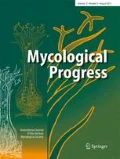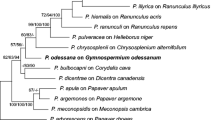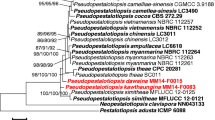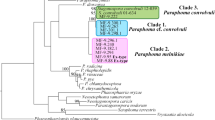Abstract
Paraboeremia was recently introduced for a distinct lineage in the family Didymellaceae. Currently, three species are included, i.e. P. adianticola, P. putaminum and P. selaginellae, all of which are plant pathogens. Paraboeremia is morphologically similar to Phoma but phylogenetically distinct. In this paper, three new species, i.e. Paraboeremia camelliae isolated from Camellia sp., P. litseae from Litsea sp., and P. oligotrophica from cave limestone, are described, illustrated and compared with closely related taxa. Phylogenetic analysis based on the multi-locus sequences of the internal transcribed spacer regions 1 and 2 and 5.8S nuclear ribosomal RNA gene (ITS), partial large subunit 28S nrDNA region (LSU), partial β-tubulin (TUB2) gene and RNA polymerase II (RPB2) gene regions confirmed the distinction of these species in Paraboeremia. These three new species were discovered from habitats and hosts that are previously unknown from this genus.




Similar content being viewed by others
References
Ariyawansa HA, Hyde KD, Jayasiri SC et al (2015) Fungal diversity notes 111–252–taxonomic and phylogenetic contributions to fungal taxa. Fungal Divers 75:27–274
Aveskamp MM, de Gruyter J, Crous PW (2008) Biology and recent developments in the systematics of Phoma, a complex genus of major quarantine significance. Fungal Divers 31:1–18
Aveskamp MM, de Gruyter J, Woudenberg JHC, Verkley GJM, Crous PW (2010) Highlights of the Didymellaceae: a polyphasic approach to characterise Phoma and related pleosporalean genera. Stud Mycol 65:1–60. doi:10.3114/sim.2010.65.01
Boerema GH (1983) Mycologisch-taxonomisch onderzoek. Phoma-soorten van de sectie Peyronellaea. Versl Meded Plantenziektenk Dienst Wageningen 159:21–25
Boerema GH, de Gruyter J, Noordeloos ME et al (2004) Phoma identification manual: differentiation of specific and infra-specific taxa in culture. CABI, Wallingford doi:10.1079/9780851997438.0000
Cai L, Hyde KD, Taylor PWJ et al (2009) A polyphasic approach for studying Colletotrichum. Fungal Divers 39:e204
Chen Q, Jiang JR, Zhang GZ, Cai L, Crous PW (2015a) Resolving the Phoma enigma. Stud Mycol 82:137–217. doi:10.1016/j.simyco.2015.10.003
Chen Q, Zhang K, Zhang G, Cai L (2015b) A polyphasic approach to characterise two novel species of Phoma (Didymellaceae) from China. Phys Chem Chem Phys 197:267–281
Collado MC, Meriluoto J, Salminen S (2007) Measurement of aggregation properties between probiotics and pathogens: in vitro evaluation of different methods. J Microbiol Methods 71:71–74. doi:10.1016/j.mimet.2007.07.005
Crous PW, Gams W, Stalpers JA, Robert V, Stegehuis G (2004) MycoBank: an online initiative to launch mycology into the 21st century. Stud Mycol 50:19–22
Crous PW, Groenewald JZ (2016) They seldom occur alone. Fungal Biol. doi:10.1016/j.funbio.2016.05.009
Cubero OF, Crespo ANA, Fatehi J, Bridge PD (1999) DNA extraction and PCR amplification method suitable for fresh, herbarium-stored, lichenized, and other fungi. Plant Syst Evol 216:243–249
De Gruyter J, Aveskamp MM, Woudenberg JHC, Verkley GJ, Groenewald JZ, Crous PW (2009) Molecular phylogeny of Phoma and allied anamorph genera: towards a reclassification of the Phoma complex. Mycol Res 113:508–519. doi:10.1016/j.mycres.2009.01.002
De Gruyter J, Noordeloos ME (1992) Contributions towards a monograph of Phoma (Coelomycetes)—I. 1. Section Phoma: Taxa with very small conidia in vitro. Persoonia 15:71–92
Hoog GD, Ende AHG (1998) Molecular diagnostics of clinical strains of filamentous Basidiomycetes. Mycoses 41:183–189
Katoh K, Standley DM (2013) MAFFT multiple sequence alignment software version 7: improvements in performance and usability. Mol Biol Evol 30:772–780. doi:10.1093/molbev/mst010
Liu YJ, Whelen S, Hall BD (1999) Phylogenetic relationships among ascomycetes: evidence from an RNA polymerse II subunit. Mol Biol Evol 16:1799–1808
Mason-Gamer RJ, Kellogg EA (1996) Testing for phylogenetic conflict among molecular data sets in the tribe Triticeae (Gramineae). Syst Biol 45:524–545
Parkinson SM, Wainwright M, Killham K (1989) Observations on oligotrophic growth of fungi on silica gel. Mycol Res 93:529–534
Posada D (2008) jModelTest: phylogenetic model averaging. Mol Biol Evol 25:1253–1256. doi:10.1093/molbev/msn083
Rayner RW (1970) A mycological colour chart. Commonwealth Mycological Institute and British Mycological Society, UK
Rehner SA, Samuels GJ (1994) Taxonomy and phylogeny of Gliocladium analysed from nuclear large subunit ribosomal DNA sequences. Mycol Res 98:625–63
Ronquist F, Teslenko M, van der Mark P et al (2012) MrBayes 3.2: efficient Bayesian phylogenetic inference and model choice across a large model space. Syst Biol 61:539–542. doi:10.1093/sysbio/sys029
Ruibal C, Platas G, Bills GF (2005) Isolation and characterization of melanized fungi from limestone formations in Mallorca. Mycol Prog 4:23–38. doi:10.1007/s11557-006-0107-7
Saccardo PA (1892) Sylloge Fungorum 10: 140. Padua, Italy
Selbmann L, de Hoog GS, Mazzaglia A, Friedmann EI, Onofri S (2005) Fungi at the edge of life: cryptoendolithic black fungi from Antarctic desert. Stud Mycol 51:1–32
Stamatakis A, Alachiotis N (2010) Time and memory efficient likelihood-based tree searches on phylogenomic alignments with missing data. Bioinformatics 26:i132–i139. doi:10.1093/bioinformatics/btq205
Su YY, Cai L (2012) Polyphasic characterisation of three new Phyllosticta spp. Persoonia 28:76–84. doi:10.3767/003158512X645334
Su YY, Qi YL, Cai L (2012) Induction of sporulation in plant pathogenic fungi. Mycology 3:195–200
Sung GH, Sung JM, Hywel-Jones NL, Spatafora JW (2007) A multi-gene phylogeny of Clavicipitaceae (Ascomycota, Fungi): Identification of localized incongruence using a combinational bootstrap approach. Mol Phylogenet Evol 44:1204–1223. doi:10.1016/j.ympev.2007.03.011
Tamura K, Stecher G, Peterson D, Filipski A, Kumar S (2013) MEGA6: molecular evolutionary genetics analysis version 6.0. Mol Biol Evol 30:2725–2729. doi:10.1093/molbev/mst197
Tanaka T (1921) New Japanese fungi: notes and translations: X. Mycologia 13:323–328
Thambugala KM, Daranagama DA, Phillips AJL et al (2016) Microfungi on Tamarix. Fungal Divers 2016:1–68. doi:10.1007/s13225-016-0371-z
Vilgalys R, Hester M (1990) Rapid genetic identification and mapping of enzymatically amplified ribosomal DNA from several Cryptococcus species. J Bacteriol 172:4238–4246
Wainwright M, Al-Talhi A (1999) Selective isolation and oligotrophic growth of Candida on nutrient-free silica gel medium. J Med Microbiol 48:1130–1130
White TJ, Bruns T, Lee SJWT, Taylor JW (1990) Amplification and direct sequencing of fungal ribosomal RNA genes for phylogenetics. PCR protocols: a guide to methods and applications 18: 315–322
Wijayawardene NN, Hyde KD, Wanasinghe DN et al (2016) Taxonomy and phylogeny of dematiaceous coelomycetes. Fungal Divers 77:1–316. doi:10.1007/s13225-016-0360-2
Woudenberg JHC, Aveskamp MM, de Gruyter J, Spiers AG, Crous PW (2009) Multiple Didymella teleomorphs are linked to the Phoma clematidina morphotype. Persoonia 22:56–62. doi:10.3767/003158509X427808
Acknowledgements
This study was financially mostly supported by Project for Fundamental Research on Science and Technology, MOST (2014FY120100) and NSFC 31322001. Jia-Rui Jiang acknowledges CAS grant (153211KYSB20160029) for providing her postgraduate studentship. Zhi-Feng Zhang, Nan Zhou and Xin Zhou were thanked for help with sample collection. Fang Liu and Yong-Zhao Diao are thanked for technical assistance in lab. LC is very grateful to Dr. Eric H.C. Mckenzie who taught him the first Hyphomycetes course in his science career.
Author information
Authors and Affiliations
Corresponding author
Additional information
Section Editor: Kevin Hyde and Marc Stadler
This article is part of the “Special Issue in honour of the 70th birthday of Dr. Eric McKenzie”.
Rights and permissions
About this article
Cite this article
Jiang, JR., Chen, Q. & Cai, L. Polyphasic characterisation of three novel species of Paraboeremia . Mycol Progress 16, 285–295 (2017). https://doi.org/10.1007/s11557-016-1253-1
Received:
Revised:
Accepted:
Published:
Issue Date:
DOI: https://doi.org/10.1007/s11557-016-1253-1




